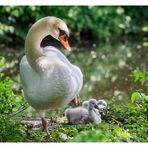As time goes by
Zwischen den beiden Aufnahmen liegen gerade einmal vier Monate. Das kleine Schwanenküken ist nun zum Jungschwan gereift. Seine fünf Geschwister haben es wohl nicht geschafft. Eine mögliche Erklärung für sein Überleben gibt vielleicht der untenstehende Text.
"Dunenküken haben ein hell silbergraues Gefieder mit einer weißen Unterseite. Der Schnabel ist schwarz, die Füße und Beine dunkelgrau. Noch nicht ausgewachsene Jungvögel haben ein dumpf graubraunes Gefieder, das im Verlauf des ersten Lebensjahres zunehmend heller wird. Der Schnabel ist noch grau bis fleischfarben, wird dabei zunehmend mehr orange. Die braunen Federn werden allmählich verloren. Ein vollständig weißes Gefieder weisen die Jungschwäne nach der Vollmauser im zweiten Lebensjahr auf. Für den Höckerschwan werden keine Unterarten beschrieben. Es wird allerdings eine Farbmorpheunterschieden, die als immutabilis oder auch „Polnischer Schwan“ bezeichnet wird. Diese Farbvariante weist kein Melanin auf, so dass die Dunenküken und Jungvögel weiß erscheinen. Sie weisen bis zur Geschlechtsreife pinkfarbene bis gelbe Füße und Beine auf und sind an diesem Merkmal identifizierbar. Ausgewachsene Schwäne dieser Farbvariante haben hellgraue bis fleischfarbene Beine. Das Auftreten dieser Farbvariante ist häufiger bei im Osten Europas brütenden Höckerschwänen sowie bei den in den USA eingeführten Schwänen zu beobachten und tritt bei weiblichen Höckerschwänen häufiger als bei Männchen auf. Ausgewachsene Höckerschwäne reagieren auf die weißen Dunenküken und Jungvögel aggressiver und diese werden früher als graubraune Jungvögel aus dem Territorium vertrieben. Ihre Mortalitätsrate ist im Vergleich zu den normalfarbenen Jungvögeln daher höher. Die Immutabilis-Variante wird jedoch früher geschlechtsreif."
Quelle: https://de.m.wikipedia.org/wiki/Höckerschwan

Eben noch...
Manuel Gloger

Eine kleine...
Manuel Gloger

Ein wachsames Auge...
Manuel Gloger

Begegnung der Kinder...
Manuel Gloger
There are just four months between the two recordings. The little swan chick has now matured to the young swan. His five siblings probably did not make it. One possible explanation for his survival may be the text below.
"Young birds, called cygnets, are not the bright white of mature adults, and their bill is dull greyish-black, not orange, for the first year. The down may range from pure white to grey to buff, with grey/buff the most common. The white cygnets have a leucistic gene. Cygnets grow quickly, reaching a size close to their adult size in approximately three months after hatching. Cygnets typically retain their grey feathers until they are at least one year old, with the down on their wings having been replaced by Flight feathers earlier that year. All mute swans are white at maturity, though the feathers (particularly on the head and neck) are often stained orange-brown by iron and tannins in the water. The cob is responsible for defending the cygnets while on the water, and will sometimes attack small watercraft, such as canoes, that it feels are a threat to its young. Mute swans can be very aggressive in defence of their nests and are highly protective of their mate and offspring. Most defensive attacks from a mute swan begin with a loud hiss and, if this is not sufficient to drive off the predator, are followed by a physical attack. The cob will additionally try and chase the predator out of his family territory, and will keep animals such as foxes and raptors at bay. In New York (outside its native range), the most common predators of cygnets are common snapping turtles. Healthy adults are rarely preyed upon, though canids such as coyotes, felidssuch as lynxes, and bears can pose a threat to infirm ones (healthy adults can usually swim away from danger unless defending nests) and there are a few cases of healthy adults falling prey to golden eagles."
Source: https://en.m.wikipedia.org/wiki/Mute_swan
Casablanca - As Time Goes By - Original Song by Sam (Dooley Wilson): https://g.co/kgs/csdLww




















† Ingeborg K 17/03/2019 12:08
Eine klasse Idee mit dieser Gegenüberstellung. Ein top Foto und danke für die Ausführungen dazu.LG Ingeborg
Gerd Frey 27/11/2018 10:50
optisch hat er keine chance gegen das küken.vg gerd
Markus 4 24/11/2018 14:52
super gegenüber gestelltHabedieehre
Markus
Diruwi 24/11/2018 1:22
Ich könnte die ja nicht auseinanderhalten ... :-)Alles Gute, Dietmar
hans-jakob 23/11/2018 19:07
Hier zeigst du uns zwei superschöne Portraits!!!LG hans-jakob
Alfred Schultz 23/11/2018 16:08
Jetzt kann das Küken voller Stolzseinen eleganten Schwanenhals
präsentieren.
Gruß - A.
Stefan Jo Fuchs 23/11/2018 7:14
anrührend, wie du diese Entwicklung beobachten und uns zeigen konntest!Du wirst noch zum Familienmitglied, wenn´s so weiterläuft! ;-)
lg stefan
Richard Schult 23/11/2018 6:40
An Tieren wie hier den Schwänen sehen wir wie im Zeitraffer das, was uns auch blüht. Schöne Gegenüberstellung.VG Richard
† Dieter Uhlig. 22/11/2018 19:03
und geht es genauso :-}Joachim Irelandeddie 22/11/2018 19:01
Das sind zwei sehr gute Aufnahme die du hier zu einer tollen Collage zusammen gefasst hast! Auch dein Text dazu ist wieder sehr informativ und gut!lg eddie
Vitória Castelo Santos 22/11/2018 18:29
Super collage!!!!!!!!!!Mark Hantelmann 22/11/2018 18:09
wunderbare GegenüberstellungLichtSchattenSucher 22/11/2018 17:22
Sehr schöne und anschauliche Gegenüberstellung in überragender Bildqualität!Gruss
Roland
Harold Thompson 22/11/2018 16:54
Nicely taken shots of the of the cygnets before they get their white plumage:-)) Harold
Doris Servos 22/11/2018 16:45
Was für eine rasante Entwicklung, sehr schön von dir festgehalten und mit sehr interessantem Text versehen!LG Doris